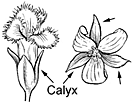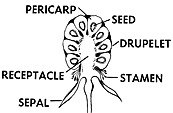Ha'a
Antidesma platyphyllum
Leafflower family (Phyllanthaceae)
Native species ()
This handsome small native tree with shiny leaves and abundant dark purple, slightly flattened, pea-sized are widely distributed through the islands. A large shrub or small tree 20–30 ft (6–9 ) high, with trunk to 1 ft (0.3 ) and open of few nearly erect branches. Bark whitish gray, smoothish to deeply furrowed, the inner bark is fibrous, pink, and bitter. Twigs slightly zigzag, with minute pressed hairs when young, raised rounded leaf scars, and very small rounded hairy buds.

©2002 Forest And Kim Starr
Flower clusters () on twigs back of leaves, 2–4 inches (5–10 ) long, with few slender finely hairy branches. Flowers male and female on different plants, small. Male flowers are nearly stalkless, consisting of about 1⁄16 inch (1.5 ) long with 4–5 4–5 long and a minute nonfunctional Female flowers are short-stalked, composed of finely hairy with 5–8 and hairless with single-celled and three very short
() are many, elliptical, nearly 3⁄8 inch (1 ) long, slightly flattened, with and shiny, turning from green to dark red, juicy. Seed single, slightly flattened.
Wood is reddish brown, fine-textured, and hard. It takes a fine polish and is suitable for cabinet work but is not found in commercial quantities. It is reported that the wood is resistant to marine borers or shipworms. The Hawaiians used the logs as anvils for beating the fibrous bark of the native shrub olonā (Touchardia Gaud.).
The reddish are edible, sweet, and have a juice that stains hands and clothes. Mixed with kamani oil (Calophyllum inophyllum), the made a bright red dye for tapa, particularly the tapa used for malos (loincloths).
Common in wet and dry forests, especially at 1500–3000 ft (457–914 ) altitude widespread through the islands.
Special area
Kokee
Champion
Height 52 ft (15.8 ), c.b.h. 6.7 ft (2 ), spread 23 ft (7 ). Kaupulehu, Kailua-Kona, Hawaii (1968).
Range
Hawaii only
Other common names
ha‘a, mehame, hamehame, mehamehame, ha‘āmaile
A second species is ha‘a or mehame, Antidesma pulvinatum Hillebr. It is distinguished by the dull green leaves notched or heart-shaped at base and with tufts of hairs in vein angles and small black less than 1⁄4 inch (6 ) long. The is rounded and symmetrical. This small tree is found on Oahu, Molokai, Maui, and Hawaii, in dry areas, especially the a‘ā (rough) lava fields at low altitudes. It is reported as common on the lava fields of South Kona, Hawaii, especially at Kapua at 2000 ft (610 ) altitude. Known only from Hawaii. Intermediate plants found together with both species on the Island of Hawaii apparently are hybrids (Antidesma kapuae Rock).
Antidesma, which has flattened seeds and smooth-edged leaves close together, is sometimes confused with Xylosma, which has prominent lenticels in the bark, round seeds, and well-spaced leaves.








